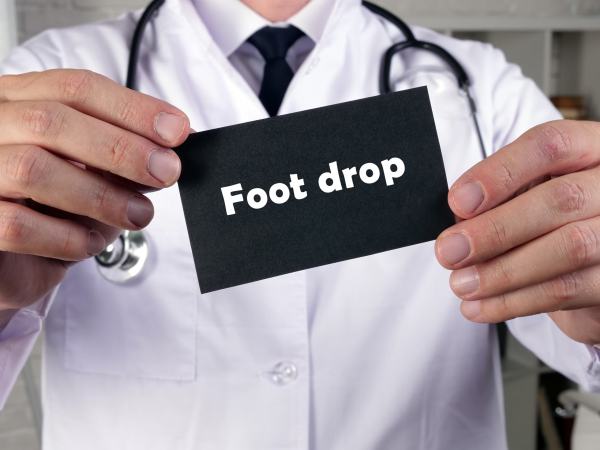What is Foot Drop?
Drop foot and foot drop are interchangeable terms that describe an abnormal nerve and muscle disorder that affects the patient’s ability to raise their foot at the ankle. It is further characterized by an inability to point the toes toward the body or move the foot at the ankle inward or outward. Pain, weakness, and numbness may accompany loss of function. Walking becomes a challenge due to the patient’s inability to control the foot at the ankle. The foot may appear floppy and the patient may drag the foot and toes while walking
Patients with foot drop usually exhibit an exaggerated or high-stepping walk called steppage gait or footdrop gait. A steppage gait is not only noticeable by the exaggerated motion of the leg in use, but by the sound the foot makes during the gait. When a person lifts the leg higher to prevent the toe drag, the heel strikes the ground with more force than the normal body weight. This causes the front half of the foot to slap to the ground as though the foot is simply being dropped to the ground. . An easy first step in telling if a person is experiencing Foot Drop is to see if they can walk on their heels only. With this condition, a person will be unable to walk only on the heels of their feet.
Foot Drop symptoms may include:
- An exaggerated, swinging hip motion. With foot drop, the hip may swing out in an effort to counteract the toes from catching the ground.
- Limp foot. Specifically, a foot that flops away from the body is another common drop foot symptom.
- Tingling, numbness and pain in the foot. Ranging from a slight tingling sensation to a complete lack of feeling in the foot, these foot drop symptoms may make everyday activities like walking and driving a car very difficult.
- Difficulty with certain activities requiring the use of the front of the foot. As just one example, foot drop may make an activity like climbing the stairs especially difficult.
- Muscle atrophy in the leg. Muscle atrophy refers to a muscle decreasing in mass and weakening. Atrophy may make it much harder to exert force with the leg and the foot.
Foot Drop Causes:
Drop Foot is not a disease but a symptom of an underlying problem. Depending on the cause, it may be either temporary or permanent. Often Drop Foot is caused by injury to the peroneal nerve deep within the lumbar and sacral spine. The peroneal nerve is a division of the sciatic nerve, the longest nerve in the body. The peroneal nerve runs along the outside of the lower leg below the knee and branches off into each ankle, foot, and the first two toes. It transmits signals to muscle groups responsible for ankle, foot, and toe movement and sensation.
The most common explanation for a dropped foot is a herniated disc at L4/L5 or L5/S1. The peroneal nerve is a branch of the sciatic nerve which runs through these levels of the spine. A disc herniation will produce discal material that narrows the space through which the peroneal nerve passes and compresses that nerve.
The peroneal nerve is susceptible to different types of injury. Spinal osteophytes, or bone spurs can also cause impingement of the affected nerve. Other conditions that can cause it are spondylolisthesis, or the slippage of one vertebral disc over another, scoliosis, or the unnatural curvature of the spine and severe lumbar spinal stenosis, or the narrowing of the spinal canal.
Cervical spinal stenosis can also be responsible for this condition, though less commonly than stenosis at L4-L5. Those with spinal upper motor neuron disease have an incidence of around 50-70% of foot drop which may be caused by compression of the spinal cord in the cervical spine. This can occur when cervical spinal stenosis becomes severe and affects the spinal cord itself rather than just the cervical spinal nerves exiting the spinal column.
Treatment:
In some cases, drop foot is a complex problem. Determining the underlying cause is one of the physician’s first considerations. The diagnostic process includes a comprehensive assessment of the patient’s symptoms, past and current medical histories, physical and neurological examinations. As well as imaging studies such as MRI (magnetic resonance imaging), and EMG (electromyogram).
Some patients find their symptoms relieved through epidural steroid injections as this can ease inflammation in or around the nerves. Such injections may also prove diagnostic of pinched nerves and give a surgeon an insight into the likelihood of spinal surgery relieving the condition on a longer-term basis.
Surgery may be necessary to correct or alleviate the underlying problem causing drop foot. For example, if drop foot is caused by nerve compression from a lumbar herniated disc, then a spinal surgical procedure can be performed to open the space where the nerve leaves the spine, through the spinal foramen by either removing part of a herniated disc through a microdiscectomy, opening the foramen through a foraminotomy, or in more complex cases, a combination of these procedures.
Sources: Stewart G. Eidelson, M.D., “Drop Foot (Foot Drop) and Steppage Gait (Footdrop Gait), Spine Universe; Washington University in St. Louis School of Medicine, “Foot Drop”; Mike Price, “The Ultimate Guide to Preventing Foot Drop”, Spinal Stenosis.org, October 24, 2011;l Spine-Health, “Foot Drop Causes”

